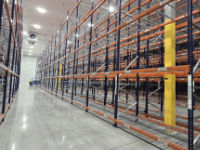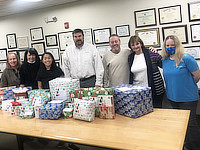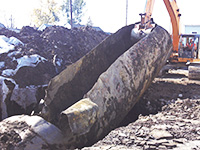Newsletter Archives
Click any image to enlarge it. Click the title to view a PDF of the full newsletter article.
2025
-
 A Measure of What Matters Most – December 2025
A Measure of What Matters Most – December 2025
As we reflect on 2025, here’s how GCI’s year measured up.
-
 Q4 Updates for Developers, Owners and Contractors – November 2025
Q4 Updates for Developers, Owners and Contractors – November 2025
Here are four quick year-end updates about mitigation for drought-impacted soils; Ohio DOD environmental grant application deadlines; firestop implementation reminders for GCs, CMs, and trade contractors; and GCI’s expansion of specialized utility installation monitoring services.
-
 PCAs Help Accurately Plan for Building Acquisition and Maintenance – June 2025
PCAs Help Accurately Plan for Building Acquisition and Maintenance – June 2025
A Property Condition Assessment (PCA) is a valuable tool that helps building investors, property managers, and purchasers better understand a property’s physical condition and probable costs to remedy deficiencies.
-
 Thermal Mapping Validates Controlled Temperature Chamber Compliance - March 2025
Thermal Mapping Validates Controlled Temperature Chamber Compliance - March 2025
Thermal mapping is the practice of collecting and analyzing data over a specified period of time to validate that Controlled Temperature Chambers and systems perform as designed to keep frozen, refrigerated, and ambient-temperature products within their specified temperature and humidity ranges for product safety, efficacy and quality.
2024
-
 Firestopping is Everyone’s Responsibility – October 2024
Firestopping is Everyone’s Responsibility – October 2024
Firestop barriers are passive systems that allow building occupants more time and a path to escape by protecting against the passage of flames, gasses and smoke through openings in fire-rated assemblies, walls and floors. Every building trade is responsible for installing firestop associated with their work.
-
 New Federal PFAS Regulations to Impact Real Estate Property Owners, Transactions and Development – July 2024
New Federal PFAS Regulations to Impact Real Estate Property Owners, Transactions and Development – July 2024
Two new U.S. EPA rules that significantly impact real estate became effective July 8, 2024. The EPA designated two widely used PFAS substances, PFOA and PFOS, as hazardous substances under CERCLA, also known as Superfund. PFAS investigation is now required for Phase I ESAs.
-
 Use of Building Envelope Consulting Practices Can Minimize Rework and Increase Profitability – April 2024
Use of Building Envelope Consulting Practices Can Minimize Rework and Increase Profitability – April 2024
Rework costs Ohio building owners and contractors millions each year, but there are steps architects, owners, and contractors can take to minimize avoidable and costly tear-outs and do-overs.
-
 Cold Weather Advisory for Concrete & Masonry Construction – January 2024
Cold Weather Advisory for Concrete & Masonry Construction – January 2024
Special measures are required to successfully place concrete and construct masonry walls and foundations during extremely cold weather. Review the protection procedures needed for soils, fresh concrete, masonry materials, mortar, and grout for various cold weather conditions.
2023
-

From Our Family to Yours – December 2023
Wishing you and your loved ones all the joys of the holiday season and a new year filled with kindness, the warmth of friendship and PEACE.
-

Advanced Drone Imaging Enhances Risk Management – July 2023
The technological advances of GCI’s newest drone captures advanced resolution and detail that helps make human work safer and improves the data that informs the work of engineers and technicians. Combined with the ability to image or reach areas not previously accessible, the result is a sizeable leap forward in terms of the info available for risk management and decision making.
-

Cement Shortage Alters Site Stabilization Approach – April 2023
Due to the huge increase in central Ohio construction and limited cement availability nationwide, the cement products used for site stabilization are projected to be in short supply throughout 2023. Developers that typically rely on cement stabilization to obtain stable subgrades and retain stability throughout construction during wet seasons, will need to consider other options.
-

How to “See” What’s Underground – January 2023
Ground penetrating radar (GPR) and electromagnetic induction profiling (EM) are complementary technologies that can detect and map underground objects and conditions without excavation. Here’s a quick review of these non-invasive tools that GCI uses to conduct geophysical surveys for environmental and construction materials assessments.
2022
-

The season of giving lasts all year round at GCI! – December 2022
GCI created the GCI/Anne Longo Memorial Fund at the Columbus Foundation in memory of co-founder Anne Longo. Since its inception in June 2014, GCI has given $325,900 to the fund and distributed 291 grants totaling $243,607. “We’re passionate about supporting the charities our clients and employees are passionate about,” says Cindy Brass, GCI’s COO, manager of charitable giving, and daughter of GCI co-founders Anne and Dan Longo. “Charitable giving has been part of GCI from the beginning.”
-

Firestopping Reminders for Fire Prevention Month – October 2022
Fire- and smoke-rated assemblies are required by Building Codes to create compartments which limit fire or smoke spread and provide time, paths and prescribed maximum path lengths for building occupants to escape safely. The purpose of firestopping is to restore the rating of fire- and smoke-rated wall and floor/ceiling assemblies destroyed due to joints and penetration by pipes, cables, ducts, busways, cable trays, and miscellaneous structural elements.
-

Five Things Developers Need to Know About ASTM’s New Phase I ESA Standard – July 2022
The proposed new ASTM Standard E1527-21 for conducting Phase I Environmental Site Assessments (ESAs) went public in late 2021 and is positioned mostly as “clarifications.” But there are several changes that could have a significant impact on real estate development projects. These are the top 5 changes GCI sees that clients should pay attention to.
-

How GCI is Addressing the Soaring Demand for Concrete Testing Services – May 2022
Concrete is one of the most commonly used building materials in the world and the demand for concrete construction-related services is soaring. Not only is construction booming, but the type of construction includes more concrete than ever before. Read on for details about the steps GCI is taking to keep pace with the increased demand.
-

Flying High and Digging Deep with Advanced Technology – March 2022
Despite the pandemic-induced shortage of computer chips, GCI has implemented exciting technology advancements during the past year. Here’s a look at the advanced GIS- and drone-assisted applications that improve precision and efficiency, provide faster turnaround times, and help control costs.
2021
-

-

Advances in BEC Technology Can Reveal Hidden Building Defects – November 2021
New building envelope testing technology can reveal pinhole-size leaks in roof membranes and wall waterproofing. This article highlights several of the newer BEC tests and how they’re being used to assess building envelope elements during construction and throughout the building lifecycle.
-

Hot Weather Concrete Strategies Everyone Needs to Know – July 2021
Damage to concrete caused by hot weather can never be fully alleviated. To avoid costly remedial actions and schedule delays due to hot weather, proper management of both construction practices and the concrete mixture are essential.
-

A Deep Dive Into Deep Foundations – April 2021
For the 5% to 10% of buildings proposed to be located on a redevelopment site, unsuitable soils, or with extraordinary load requirements, ground improvement or deep foundations are needed to avoid the risk of excessive settlement. This article digs into the foundation systems that support some of Ohio’s most remarkable buildings.
-

A Brief Introduction to the Geohazards of the Geographic Regions of Ohio – March 2021
Each of Ohio’s five distinct geographical provinces has specific geological hazards. This article reviews those geohazards and their associated conditions.
-

Concrete, Masonry & Soils Guidelines for Wintertime Construction – January 2021
Special measures are required to successfully place concrete and construct masonry walls and foundations during cold weather. This article reviews the protection procedures needed for soils, fresh concrete, masonry materials, mortar, and grout for various cold weather conditions.
2020
-

Season of Giving – December 2020
By most measures, 2020 has been a remarkably difficult year. Although many of our holiday celebrations will look quite different this year, charitable giving is one tradition that endures stronger than ever.
-

RCC Delivers a Stronger Pavement Faster at Less Cost – November 2020
Roller Compacted Concrete (RCC) is a type of pavement that allows traffic onto the pavement much sooner than conventional concrete, so contractors can deliver time-critical projects faster. RCC is used for any type of heavy-use or industrial pavement when strength and durability are especially important. Applications include staging and storage areas, loading docks, parking, streets and intersections, low-speed roads, and intermodal facilities.
-

Remove Universal Waste to Mitigate Redevelopment Risk – September 2020
Universal waste is an often-overlooked waste stream needing special handling and disposal when demolishing or renovating buildings. Universal waste often contains hazardous substances such as PCB-containing oils, mercury, refrigerants, and lead. Here’s a quick overview about how to mitigate risks from universal waste during building demolition and renovation.
-

Engineered repairs of embankment slips caused by extreme rain events allow roads in southeastern Ohio counties to reopen. The advantages and flexibility of post-tensioned (PT) concrete construction has led to an astonishing jump in the number of recent applications. GCI adds residential duct tightness testing to Building Envelope Consulting services. Ben Sershen earns Drone Pilot’s License.
-

GCI Expands Building Envelope Consulting Services – January 2020
Independent review, testing and observation of the building envelope throughout design and construction confirms that building envelope systems are installed according to specifications and the building functions as intended, which means limiting the movement of water, air, vapor and thermal within or through that envelope.
2019
-

Managing Relative Humidity to Prevent Flooring Problems - February 2019
Water intrusion and moisture related problems are among the most expensive issues for building owners to address. Managing relative humidity is critically important during building construction and throughout the building lifecycle to prevent mold and mildew growth and issues related to floor coverings.
2018
-

Geofabrics and Geogrids for Wet Soils - November 2018
When excessively wet soils are encountered during construction, synthetic geogrids and geofabrics can be used to improve soil separation and stabilization characteristics so construction projects can proceed.
-

Confused About Special Inspections? - June 2018
Special inspections are confusing! Here are answers to the six most frequently asked questions regarding special inspection requirements, responsibilities, budgets and how they impact occupancy permits.
-

Extreme Rain Events are Ohio’s New Normal - March 2018
Weather patterns have changed, so we can’t just take it for granted that what we did in the past will work well now and into the future. Planning for the likely occurrence of several of Ohio’s “new normal” rain events during construction means engineering, budgeting and scheduling for temporary site drainage, de-watering operations, soil modification and soil stabilization approaches.
2017
-
 2017 Year in Review
2017 Year in Review
The year’s most unusual projects, new services added, charitable organizations supported, and other notable GCI milestones.
-
 Steel Inspection Tips for Every Building Owner and Contractor - October 2017
Steel Inspection Tips for Every Building Owner and Contractor - October 2017
Steel inspection guidelines and tips that every contractor, building owner, and facility manager should know to help construct steel building components and implement preventive maintenance programs to reduce the risk of emergencies.
-
 Welder Certification and Welding Procedures Qualification – October 2017 addendum
Welder Certification and Welding Procedures Qualification – October 2017 addendum
Maintain compliance and avoid schedule delays by making sure each welder’s welding performance qualification (WQTR) is AWS certified and the production companies, fabrication shops and field erection companies working on your project have qualified all welding procedures (WPS).
-
 Revisions to Ohio UST Regulations, Vapor Intrusion (VI) solutions, and GCI’s expanded welding lab - June 2017
Revisions to Ohio UST Regulations, Vapor Intrusion (VI) solutions, and GCI’s expanded welding lab - June 2017
Any newly discovered Underground Storage Tanks (USTs), even on projects already under construction, must comply with the new rules published in September 2017. Plus, new passive vapor mitigation system option for new construction projects, and GCI completes new fully-equipped in-house welding laboratory for welder performance qualification (WQTR) and welding procedures qualification (WPS).
-
 Vapor Intrusion Solutions - June 2017
Vapor Intrusion Solutions - June 2017
Combined technologies treat chlorinated and other solvents at former manufacturing site redeveloped for residential use.
-
 The Rise of Post Tensioned Construction - March 2017
The Rise of Post Tensioned Construction - March 2017
Post-tensioned (PT) concrete construction is a method of reinforcing (strengthening) concrete or other materials with high-strength steel cables or strands. The PT method creates longer spans more efficiently than traditional reinforced concrete. Buildings can have larger interior spaces unobstructed by vertical structural supports, irregular or random loads can be accommodated, and longer spans can be achieved with less concrete and rebar material.
2016
-
 How to Fast-track FRA Inspections - November 2016
How to Fast-track FRA Inspections - November 2016
To provide timely inspections for clients, contractors and property owners, in 2015 the City of Columbus Inspection Department approved GCI to perform FRA inspections in lieu of the City’s inspectors.
-
 What You Need to Know About Hot Weather Concrete - July 2016
What You Need to Know About Hot Weather Concrete - July 2016
Damage to concrete caused by hot weather can never be fully alleviated. So proper management of both construction practices and the concrete mixture are essential to minimize the effects of hot weather and prevent decreased strength, decreased durability due to cracking, and increased variability of surface appearance.
-
 Making Space for One Million People - June 2016
Making Space for One Million People - June 2016
Many of central Ohio’s new residents will live and work in buildings constructed on redeveloped sites and infill properties. Redevelopment reduces land consumption and increases the efficiency of infrastructure. But there are geotechnical and environmental challenges that developers, contractors and architects must consider when sites transition from one- or two-story structures to buildings with as many as 25 stories.
-
 Downtown Columbus Redevelopment Projects - June 2016
Downtown Columbus Redevelopment Projects - June 2016
This map shows recent Columbus sites that have been redeveloped from one- or two-story buildings to mid- and high-rise structures.
-
 Cold Weather Masonry Practices & Protection - January 2016
Cold Weather Masonry Practices & Protection - January 2016
Cold weather masonry construction may proceed at temperatures below freezing provided mortar/grout ingredients are heated and new masonry construction is protected from freezing ambient temperatures. Read more about recommended construction practices for cold weather masonry projects.
2015
-
 2015 Year in Review – December 2015
2015 Year in Review – December 2015
2015’s notable projects and milestones.
-
 Tips for Staying in Compliance - October, 2015
Tips for Staying in Compliance - October, 2015
Updates and compliance tips for Asbestos Containing Material (ACM) Surveys, Clean Water Rule revisions, and lead-based paint inspections. Plus, GCI approved to perform city of Columbus FRRA Inspections.
-
 Heritage Cooperative Six-Day Continuous Concrete Pour - July 2015
Heritage Cooperative Six-Day Continuous Concrete Pour - July 2015
With extraordinary preparation, a highly skilled crew and trusted partners, a lot can be accomplished in just one week. Take a look at the progression photos as 500 truckloads of concrete became a 14-story grain silo during a six-day continuous pour.
-
 Concrete Facts Every Building Owner and Contractor Must Know - May 2015
Concrete Facts Every Building Owner and Contractor Must Know - May 2015
Proper management of moisture and relative humidity must begin during building design and continue throughout the building’s useful life. Here are 10 essential moisture management factors that every general contractor, construction manager, building owner, architect, and property manager should know in order to properly manage risk, project schedules, and building maintenance.
-
 Cold Weather Concrete Placement - January 2015
Cold Weather Concrete Placement - January 2015
Construction projects needn’t stop due to freezing temperatures and winter weather, but appropriate measures must be taken so that cold weather concrete placement is successful.
2014
-
 Building Solid Foundations on Wet Soils - April 2014
Building Solid Foundations on Wet Soils - April 2014
How to use soil stabilization and soil modification to keep your projects on track despite wet site conditions.
-
 Impact of the New Phase I ESA Standards & Funding Environmental Assessments and Cleanup Projects - January 2014
Impact of the New Phase I ESA Standards & Funding Environmental Assessments and Cleanup Projects - January 2014
Review the five key changes that will affect how Phase I ESAs are conducted and the impact on projects. Plus, funding sources for environmental assessment and cleanup activities for a redevelopment project.
2013
-
 Special Inspection Requirements for Occupancy Permits - October 2013
Special Inspection Requirements for Occupancy Permits - October 2013
Special inspections must be performed throughout the construction process to avoid the denial of occupancy permits, project delays and costly rework. Here are answers to the most common special inspections questions fielded by GCI staff.
-
 Strategies for Hot Weather Concrete Pours - July 2013
Strategies for Hot Weather Concrete Pours - July 2013
pouring concrete during hot, dry summer weather creates unique challenges that must be properly addressed to avoid schedule delays and costly remedial actions. Here are strategies to help make sure the concrete pours on your project are prepared, finished and cured properly.


